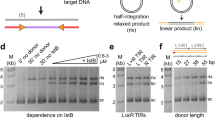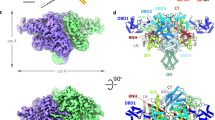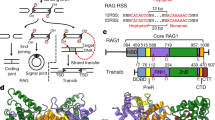Abstract
Transposases and retroviral integrases promote the movement of DNA segments to new locations within and between genomes. These recombinases function as multimeric protein–DNA complexes. Recent success in solving the crystal structure of a Tn5 transposase–DNA complex provides the first detailed structural information about a member of the transposase/integrase superfamily in its active, DNA-bound state. Here, we summarize the reactions catalyzed by transposases and integrases and review the Tn5 transposase–DNA co-crystal structure. The insights gained from the Tn5 structure and other available structures are considered together with biochemical and genetic data to discuss features that are likely to prove common to the catalytic complexes used by members of this important protein family.
This is a preview of subscription content, access via your institution
Access options
Subscribe to this journal
Receive 12 print issues and online access
$189.00 per year
only $15.75 per issue
Buy this article
- Purchase on Springer Link
- Instant access to full article PDF
Prices may be subject to local taxes which are calculated during checkout






Similar content being viewed by others
Notes
NOTE: A production error resulted in incorrect reference numbering in both the original print and web versions of this Review. On April 25, 2001, the full text and PDF were updated on the web; both are now correct. The correct version was also printed in the May issue as an Erratum . We apologize for any confusion this may have caused.
References
Lander, E.S. et al. Initial sequencing and analysis of the human genome. Nature 409, 860–921 (2001).
Yang, W. & Steitz, T.A. Recombining the structures of HIV integrase, RuvC and RNase H. Structure 3, 131–134 (1995).
Rice, P., Craigie, R. & Davies, D.R. Retroviral integrases and their cousins. Curr. Opin. Struct. Biol. 6, 76–83 (1996).
Mizuuchi, K. Polynucleotidyl transfer reactions in site-specific DNA recombination. Genes Cells 2, 1–12. (1997).
Kennedy, A.K., Guhathakurta, A., Kleckner, N. & Haniford, D.B. Tn10 transposition via a DNA hairpin intermediate. Cell 95, 125–134 (1998).
Bhasin, A., Goryshin, I.Y. & Reznikoff, W.S. Hairpin formation in Tn5 transposition. J. Biol. Chem. 274, 37021–37029 (1999).
Fugmann, S.D., Lee, A.I., Shockett, P.E., Villey, I.J. & Schatz, D.G. The RAG proteins and V(D)J recombination: complexes, ends, and transposition. Annu. Rev. Immunol. 18, 495–527 (2000).
Kim, D.R., Park, S.J. & Oettinger, M.A. V(D)J recombination: site-specific cleavage and repair. Mol. Cell 10, 367–374 (2000).
Sarnovsky, R.J., May, E.W. & Craig, N.L. The Tn7 transposase is a heteromeric complex in which DNA breakage and joining activities are distributed between different gene products. EMBO J. 15, 6348–6361 (1996).
Davies, D.R., Goryshin, I.Y., Reznikoff, W.S. & Rayment, I. Three-dimensional structure of the Tn5 synaptic complex transposition intermediate. Science 289, 77–85 (2000).
Steitz, T.A. & Steitz, J.A. A general two-metal ion mechanism for catalytic RNA. Proc. Natl. Acad. Sci. USA 90, 6498–6502 (1993).
Keck, J.L., Goedken, E.R. & Marqusee, S. Activation/attenuation model for RNase H. A one-metal mechanism with second-metal inhibition. J. Biol. Chem. 273, 34128–34133 (1998).
Huang, H., Chopra, R., Verdine, G.L. & Harrison, S.C. Structure of a covalently trapped catalytic complex of HIV-1 reverse transcriptase: implications for drug resistance. Science 282, 1669–1675 (1998).
Wlodawer, A. Crystal structures of catalytic core domains of retroviral integrases and role of divalent cations in enzymatic activity. Adv. Virus Res. 52, 335–350 (1999).
Kovall, R.A. & Matthews, B.W. Type II restriction endonucleases: structural, functional and evolutionary relationships. Curr. Opin. Chem. Biol. 3, 578–583 (1999).
Steitz, T.A. DNA polymerases: structural diversity and common mechanisms. J. Biol. Chem. 274, 17395–17398 (1999).
Rezsohazy, R., Hallet, B., Delcour, J. & Mahillon, J. The IS4 family of insertion sequences: evidence for a conserved transposase motif. Mol. Microbiol. 9, 1283–1295 (1993).
Bolland, S. & Kleckner, N. The three chemical steps of Tn10/IS10 transposition involve repeated utilization of a single active site. Cell 84, 223–233 (1996).
Pribil, P.A. & Haniford, D.B. Substrate recognition and induced DNA deformation by transposase at the target-capture stage of Tn10 transposition. J. Mol. Biol. 303, 145–159 (2000).
Cai, M. et al. Solution structure of the N-terminal zinc binding domain of HIV-1 integrase. Nature Struct. Biol. 4, 567–577 (1997).
Eijkelenboom, A.P. et al. The solution structure of the amino-terminal HHCC domain of HIV-2 integrase: a three-helix bundle stabilized by zinc. Curr. Biol. 7, 739–746 (1997).
Schumacher, S. et al. Solution structure of the Mu end DNA-binding Iβ subdomain of phage Mu transposase: modular DNA recognition by two tethered domains. EMBO J. 16, 7532–7541 (1997).
Clubb, R.T., Schumacher, S., Mizuuchi, K., Gronenborn, A.M. & Clore, G.M. Solution structure of the Iγ subdomain of the Mu end DNA-binding domain of phage Mu transposase. J. Mol. Biol. 273, 19–25 (1997).
van Pouderoyen, G., Ketting, R.F., Perrakis, A., Plasterk, R.H. & Sixma, T.K. Crystal structure of the specific DNA-binding domain of Tc3 transposase of C. elegans in complex with transposon DNA. EMBO J. 16, 6044–6054 (1997).
Williams, T.L., Jackson, E.L., Carritte, A. & Baker, T.A. Organization and dynamics of the Mu transpososome: recombination by communication between two active sites. Genes Dev. 13, 2725–2737 (1999).
Savilahti, H. & Mizuuchi, K. Mu transpositional recombination: donor DNA cleavage and strand transfer in trans by the Mu transposase. Cell 85, 271–280 (1996).
Namgoong, S.Y. & Harshey, R.M. The same two monomers within a MuA tetramer provide the DDE domains for the strand cleavage and strand transfer steps of transposition. EMBO J. 17, 3775–3785 (1998).
Aldaz, H., Schuster, E. & Baker, T.A. The interwoven architecture of the Mu transposase couples DNA synapsis to catalysis. Cell 85, 257–269 (1996).
Haren, L., Ton-Hoang, B. & Chandler, M. Integrating DNA: transposases and retroviral integrases. Annu. Rev. Microbiol. 53, 245–81 (1999).
Chen, J.C. et al. Crystal structure of the HIV-1 integrase catalytic core and C-terminal domains: a model for viral DNA binding. Proc. Natl. Acad. Sci. USA 97, 8233–8238 (2000).
Chen, Z. et al. X-ray structure of simian immunodeficiency virus integrase containing the core and C-terminal domain (residues 50–293) — an initial glance of the viral DNA binding platform. J. Mol. Biol. 296, 521–533 (2000).
Yang, Z.N., Mueser, T.C., Bushman, F.D. & Hyde, C.C. Crystal structure of an active two-domain derivative of Rous sarcoma virus integrase. J. Mol. Biol. 296, 535–548 (2000).
Asante-Appiah, E. & Skalka, A.M. HIV-1 integrase: structural organization, conformational changes, and catalysis. Adv. Virus Res. 52, 351–369 (1999).
Esposito, D. & Craigie, R. HIV integrase structure and function. Adv. Virus Res. 52, 319–333 (1999).
Heuer, T.S. & Brown, P.O. Photo-crosslinking studies suggest a model for the architecture of an active human immunodeficiency virus type 1 integrase–DNA complex. Biochemistry 37, 6667–6678 (1998).
Lavoie, B.D., Chan, B.S., Allison, R.G. & Chaconas, G. Structural aspects of a higher order nucleoprotein complex: induction of an altered DNA structure at the Mu–host junction of the Mu type 1 transpososome. EMBO J. 10, 3051–3059 (1991).
Rice, P. & Mizuuchi, K. Structure of the bacteriophage Mu transposase core: a common structural motif for DNA transposition and retroviral integration. Cell 82, 209–220 (1995).
Krementsova, E., Giffin, M.J., Pincus, D. & Baker, T.A. Mutational analysis of the Mu transposase. Contributions of two distinct regions of domain II to recombination. J. Biol. Chem. 273, 31358–31365 (1998).
Namgoong, S.Y. et al. Mutational analysis of domain IIβ of bacteriophage Mu transposase: domains IIα and IIβ belong to different catalytic complementation groups. J. Mol. Biol. 275, 221–232 (1998).
Turlan, C. & Chandler, M. Playing second fiddle: second-strand processing and liberation of transposable elements from donor DNA. Trends Microbiol. 8, 268–274 (2000).
Hickman, A.B. et al. Unexpected structural diversity in DNA recombination: the restriction endonuclease connection. Mol. Cell 5, 1025–1034 (2000).
Kennedy, A.K., Haniford, D.B. & Mizuuchi, K. Single active site catalysis of the successive phosphoryl transfer steps by DNA transposases: insights from phosphorothioate stereoselectivity. Cell 101, 295–305 (2000).
Stellwagen, A.E. & Craig, N.L. Mobile DNA elements: controlling transposition with ATP-dependent molecular switches. Trends Biochem. Sci. 23, 486–490 (1998).
Lee, M.S. & Craigie, R. A previously unidentified host protein protects retroviral DNA from autointegration. Proc. Natl. Acad. Sci. USA 95, 1528–1533 (1998).
Carson, M. Ribbons. Macromol. Crystallogr. B 277, 493–505 (1997).
Lavoie, B.D. & Chaconas, G. Transposition of phage Mu DNA. Curr. Top. Microbiol. Immunol. 204, 83–102 (1996).
Kleckner, N., Chalmers, R.M., Kwon, D., Sakai, J. & Bolland, S. Tn10 and IS10 transposition and chromosome rearrangements: mechanism and regulation in vivo and in vitro. Curr. Top. Microbiol. Immunol. 204, 49–82 (1996).
Reznikoff, W.S. et al. Tn5: A molecular window on transposition. Biochem. Biophys. Res. Commun. 266, 729–734. (1999).
Craig, N.L. Transposon Tn7. Curr. Top. Microbiol. Immunol. 204, 27–48. (1996).
Bolland, S. & Kleckner, N. The two single-strand cleavages at each end of Tn10 occur in a specific order during transposition. Proc. Natl. Acad. Sci. USA 92, 7814–7818 (1995).
Nicholls, A., Sharp, K.A. & Honig, B. Protein folding and association: insights from the interfacial and thermodynamic properties of hydrocarbons. Proteins 11, 281–296 (1991).
Acknowledgements
We thank B. Burton, I. Goldhaber-Gordon, L. Roldan, T. Sokolsky, T. Williams, K. Swinger and C. Correll for helpful comments on the manuscript. Work on transposases in T.A.B.'s lab is supported by the NIH and in P.A.R.'s lab by the University of Chicago Faculty Research Fund. T.A.B. is an employee of the Howard Hughes Medical Institute.
Author information
Authors and Affiliations
Corresponding author
Rights and permissions
About this article
Cite this article
Rice, P., Baker, T. Comparative architecture of transposase and integrase complexes. Nat Struct Mol Biol 8, 302–307 (2001). https://doi.org/10.1038/86166
Received:
Accepted:
Issue Date:
DOI: https://doi.org/10.1038/86166
This article is cited by
-
Mobility of mPing and its associated elements is regulated by both internal and terminal sequences
Mobile DNA (2023)
-
Structural insights into the evolution of the RAG recombinase
Nature Reviews Immunology (2022)
-
A chromosomal connectome for psychiatric and metabolic risk variants in adult dopaminergic neurons
Genome Medicine (2020)
-
A Mos1 transposase in vivo assay to screen new HIV-1 integrase inhibitors
Genetica (2018)
-
Comparative genomic analysis of six new-found integrative conjugative elements (ICEs) in Vibrio alginolyticus
BMC Microbiology (2016)



